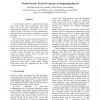Free Online Productivity Tools
i2Speak
i2Symbol
i2OCR
iTex2Img
iWeb2Print
iWeb2Shot
i2Type
iPdf2Split
iPdf2Merge
i2Bopomofo
i2Arabic
i2Style
i2Image
i2PDF
iLatex2Rtf
Sci2ools
FGR
2002
IEEE
2002
IEEE
Visual Prosody: Facial Movements Accompanying Speech
As we articulate speech, we usually move the head and exhibit various facial expressions. This visual aspect of speech aids understanding and helps communicating additional information, such as the speaker’s mood. In this paper we analyze quantitatively head and facial movements that accompany speech and investigate how they relate to the text’s prosodic structure. We recorded several hours of speech and measured the locations of the speakers’ main facial features as well as their head poses. The text was evaluated with a prosody prediction tool, identifying phrase boundaries and pitch accents. Characteristic for most speakers are simple motion patterns that are repeatedly applied in synchrony with the main prosodic events. Direction and strength of head movements vary widely from one speaker to another, yet their timing is typically well synchronized with the spoken text. Understanding quantitatively the correlations between head movements and spoken text is important for synth...
| Added | 14 Jul 2010 |
| Updated | 14 Jul 2010 |
| Type | Conference |
| Year | 2002 |
| Where | FGR |
| Authors | Hans Peter Graf, Eric Cosatto, Volker Strom, Fu Jie Huang |
Comments (0)

